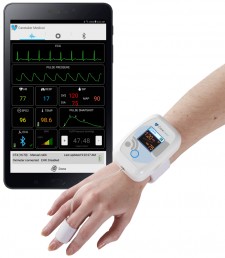Caretaker Medical Receives New Investment From Philips and Others to Enhance Wireless 'Beat by Beat' Blood Pressure and Continuous Vital Signs Platform for Remote and 'Clinically-Distanced' Patient Monitoring

CHARLOTTESVILLE, Va., June 2, 2020 (Newswire.com) - Caretaker Medical, a leader in clinical-grade wireless patient monitoring and maker of the Caretaker® wearable patient monitor that utilizes a simple Finger Cuff to remotely measure “Beat by Beat” Continuous Blood Pressure and multiple vital signs has announced the completion of a Series B funding round from new investors Philips and Ming Capital, with participation from existing investors including IrishAngels, Felton Group, and others.
The new funding will be used to add resources to address growing sales and global demand for safe, “clinically distanced” monitoring of quarantined patients and also to complete development of its Next-Generation platform that adds wireless hemodynamic and cardiac monitoring functions using the company’s patented Pulse Decomposition Analysis technology and machine learning algorithms.
The Caretaker® patient monitor measures continuous, uninterrupted Blood Pressure, Heart Rate, Respiration Rate, Temperature, SpO2, and other Vital Signs across the full continuum of care in a completely wire-free form factor, allowing clinicians to remotely view ICU-Quality data while safely distanced from contagious patients. Using Caretaker’s realtime tablet application, remote cloud portal, or data integration with other platforms like Philips IntelliVue monitors, medical staff can monitor their patients wirelessly from virtually anywhere and take swift actions early when health deterioration is suspected.
Peter Ziese, General Manager of Monitoring & Analytics at Philips said, “The expertise of Caretaker Medical is complementary to our strengths in enterprise patient monitoring and predictive analytics. During their participation in our start-up acceleration program, we were impressed by Caretaker’s innovative approach to wireless, continuous patient monitoring in various high acuity settings in the hospital. We look forward to collaborating together on an integrated solution that helps hospitals and health systems achieve the quadruple-aim of improved outcomes, enhanced patient and staff experience, and lower costs.”
Jeff Pompeo, President & CEO of Caretaker Medical added, “We are excited to have Philips and Ming Capital join our investor group, and grateful for the continued strong support from our existing investors. We’re particularly pleased to be collaborating with market leader Philips, with whom we share a passion for creating digital health innovations that improve lives, and we look forward to working closely together. The COVID-19 pandemic has clearly demonstrated the need for technologies beyond traditional telehealth, that maximize patient care while minimizing costs without compromising quality of care or health risks to medical staff. Our Caretaker® delivers critical-care grade continuous BP and Vitals without an invasive Arterial Catheter, wires or hoses, for clinicians to view safely distanced from virtually anywhere.”
The Caretaker wireless vital signs and Beat-by-Beat remote monitoring platform is FDA Cleared, CE-Mark certified and available for purchase now. Hospitals and clinics are successfully using Caretaker to wirelessly monitor Quarantined COVID-19 patients and across a wide range of in-patient and out-patient clinical settings.
About CareTaker Medical
CareTaker Medical develops wireless medical devices and affordable, innovative, patient monitoring solutions that improve outcomes, increase clinician productivity, and maximize patient compliance without compromising patient comfort.
The wearable CareTaker® patient monitor enables uninterrupted wire-free real-time vital signs and continuous “Beat by Beat” Blood Pressure monitoring throughout the full continuum of care, from clinic and hospital, to patient transport, and home monitoring after discharge. The CareTaker patented technology delivers “ICU Quality” continuous measurements without intrusive arterial catheters or cumbersome wires, giving clinicians the ability to recognize deteriorating hemodynamic trends earlier for faster interventions while providing a more comprehensive view of patient vital signs status.
More information is available at www.CareTakerMedical.net
Source: Caretaker Medical